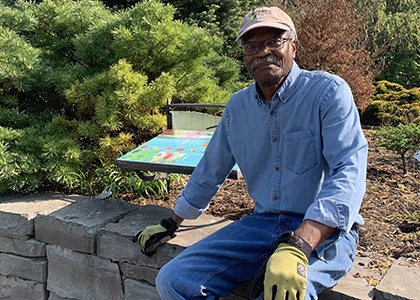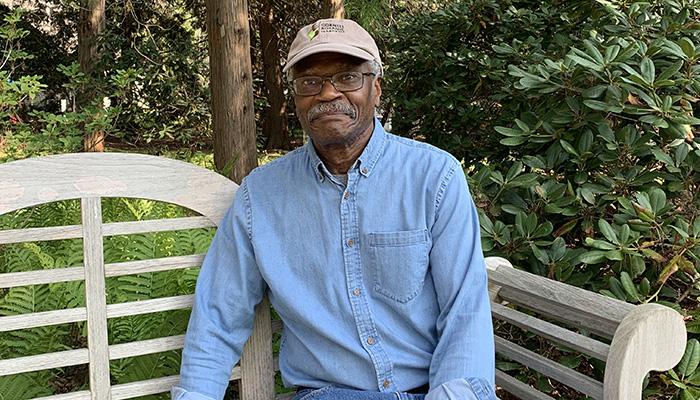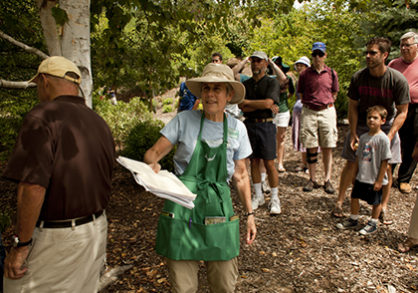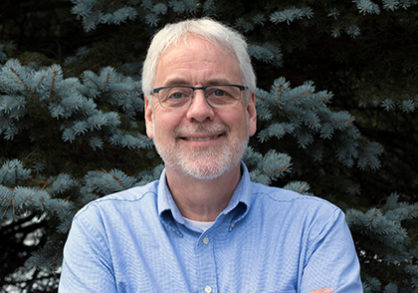
“In my classes, I had found that some aspects of what I was teaching had a lot of technicalities, and the students needed to learn the process. So I had the students think about what they were interested in and also projects where the process was utilized in history. One of those ways was using botanicals and drawing plants.
I started collaborating with not only different individuals at Plant Sciences but also those at Cornell Botanic Gardens. My students made portfolios with them where students could go in and draw with the various object matter. The collaborators would present to the students a lecture about their specialty, and then it was a matter of learning the lecture subject matter and producing work dealing with what they learned. We also did portfolios with invasive species in plants, and through a field trip with the director of natural resources, Todd Bittner, were able to go to different locations and create different drawings. These portfolios enabled the students to learn quite a bit about other subject matters, how to present them, and how to use certain approaches when thinking about them. These portfolios were a great impetus for teaching.
Another thing I came to understand from conversations with students was that they didn’t know the Botanic Gardens were there or even what they were. So, I started thinking that, well, this is a way to really introduce them to Cornell Botanic Gardens and help them produce a project at the same time; helping everything that grows there in that space. I took it on as a mission in classes to do a project in that location, or at least go to visit and get to know something about it. It’s really a wonderful facility that should be cherished by the university students and no matter what, kept and maintained throughout the coming future of the university.

Gardens have become engrained in my life and part of my existence. My wife and I love to visit gardens around the world, and I have a perennial garden and vegetable one at home even. Currently, I’m on the Botanic Gardens advisory board and since retiring, I have become a volunteer in the herb garden, taking care of it in various forms. I remain dedicated in a big way. Over the years I have seen things evolve in a large way. There are so many plans in place, and all of it is a continual effort to maintain the importance and beauty of the Botanic Gardens, but also to give it a kind of traction. To have it understood as a place of research for plant sciences and other colleges to be able to utilize in learning about biodiversity, the study of plants, and their use in the world. That’s what I would try to talk to students about as well when I did projects with them.
I even got to do a collaboration on a seminar course on sustainability. Along with other staff, we had students produce a large accordion-style book of different areas in and around the herb garden area. So, that’s an example of more interaction with entities on campus that has occurred and which continues. It’s all about efforts to make it known that the Botanic Gardens are there for a wonderful purpose as well as to invite more colleges to collaborate and utilize it, and understand its importance on a global scale. I want to see more people understand the gardens as solace, peacefulness, and improvising health as well. The changes that have brought more attention to the Cornell Botanic Gardens are always welcome in my opinion as are the discussions I’ve been involved in to make efforts to improve the relationship with students, having them feel comfortable being there and having it as part of their educational experience while at Cornell.
A lot of schools don’t have this sort of living museum per se. We are very fortunate. I keep coming back to how important the Cornell Botanic gardens are particularly with climate change and biodiversity in our world. I think it’s very important to have such a place in a university and to have more people celebrate its importance. Students need to know it’s theirs to go to, whether through courses, visiting with parents, or for respite and its calming, tranquil nature. That is something I always try to emphasize to everyone that I talk to about it. I think it can work wonders.”

Gregory Page, an emeritus associate professor of print media, is now a dedicated Faculty Fellow and volunteer at the Cornell Botanic Gardens, working to maintain the beauty and health of our collection. He has a marvelous past working with students and Cornell faculty across departments to create projects and inspire thinking about plants that incorporate art and encouragement to take advantage of the great usefulness of the Botanic Gardens.
Valerie’s Story!
Valerie Aymer speaks on how our gardens have been of great use in her students’ practice of Landscape Architecture, as well as her own.
Teresa’s Story!
Garden Guide and Master Gardener Teresa Craighead shares how a space in her life was filled and grew into bountiful opportunities with the Cornell Botanic Gardens.
Kevin’s Story!
Student and Public Engagement Coordinator Kevin Moss tells a heartwarming story stemming from his love for a past tree in the Botanic Gardens.


